DISPLAY II
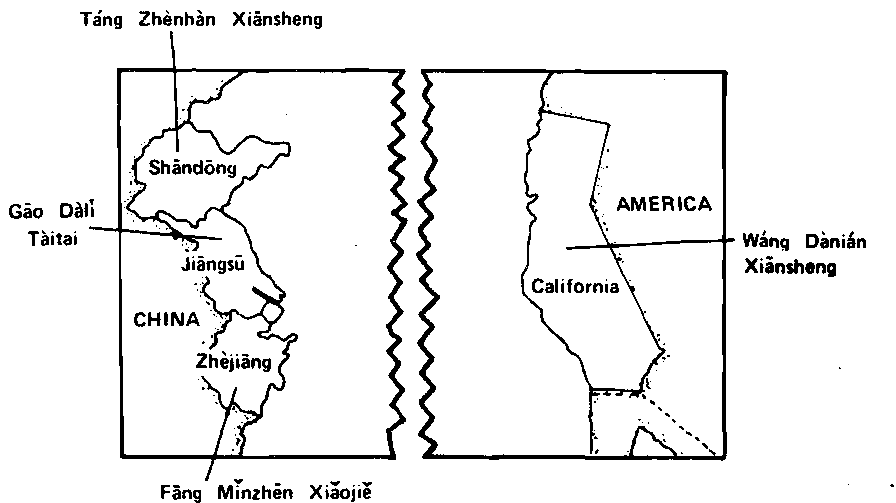
CM 0181 S
A MODULAR APPROACH
MODULE 1: ORIENTATION
MODULE 2: BIOGRAPHIC INFORMATION
SPONSORED BY AGENCIES OF THE UNITED STATES AND CANADIAN GOVERNMENTS
This publication is to be used primarily in support of instructing military personnel as part of the Defense Language Program (resident and nonresident). Inquiries concerning the use of materials, including requests for copies, should be addressed to:
Defense Language Institute
Foreign Language Center
Nonresident Training Division
Presidio of Monterey, CA 93944-5006
Topics in the areas of politics, international relations, mores, etc., which may be considered as controversial from some points of view, are sometimes included in the language instruction for DLIFLC students since military personnel may find themselves in positions where a clear understanding of conversations or written materials of this nature will be essential to their mission. The presence of controversial statements-whether real òr apparent-in DLIFLC materials should not be construed as representing the opinions of the writers, the DLIFLC, or the Department of Defense.
Actual brand names and businesses are sometimes cited in DLIFLC instructional materials to provide instruction in pronunciations and meanings. The selection of such proprietary terms and names is based solely on their value for instruction in the language. It does not constitute endorsement of any product or commercial enterprise, nor is it intended to invite a comparison with other brand names and businesses not mentioned.
In DLIFLC publications, the words he, him, and/or his denote both masculine and feminine genders. This statement does not apply to translations of foreign language texts.
The DLIFLC may not have full rights to the materials it produces. Purchase by the customer does net constitute authorization for reproduction, resale, or showing for profit. Generally, products distributed by the DLIFLC may be used in any not-for-profit setting without prior approval from the DLIFLC.
Example: (This example is limited to surnames.) The surnames H5, Hú, Hǔ, and Hù are listed on the chalkboard. Speaker 1 has taken the card for Hǔ from the deck of surname cards.
|
S2: NI xìng Hú ma? | |
|
SI |
Wo bú xìng Hú. |
|
S3 |
Nī xìng Hù ma? |
|
SI |
Wo bú xìng Hù, |
|
Sk |
Nī xìng Hū maí |
|
SI |
Wo bú xìng Hū. |
|
S2 |
Ni xìng Hǔ. |
|
SI |
W5 xìng Hǔ. |
Practice Points: Xing* jiào, and ma. Also, the Pronunciation and Romanization Module through Tape k~~Cor through Tape 5 if you have studied P8cR 5)-
Standard Chinese: A Modular Approach originated in an interagency conference held at the Foreign Service Institute in August 1973 to address the need generally felt in the U.S. Government language training community for improving and updating Chinese materials to reflect current usage in Beijing and Taipei,
The conference resolved to develop materials which were flexible enough in form and content to meet the requirements of a vide range of government agencies and academic institutions.
A Project Board was established consisting of representatives of the Central Intelligence Agency Language Learning Center, the Defense Language Institute, the State Department1s Foreign Service Institute, the Cryptologic School of the National Security Agency, and the U.S. Office of Education, later joined *by the Canadian Forces Foreign Language School. The representatives have included Arthur T. McNeill, John Hopkins, and John Boag (CIA); Colonel John F. Elder III, Joseph C. Hutchinson, Ivy Glbiau, and Major Bernard Muller-Thym (DLI); James R. Frith and John B. Ratlijff III (PSI); Kazuo Shìtama (NSA); Richard T. Thompson and Julia Petrov (OE); and Lieutenant Colonel George Kozoriz (CFFLS),
The Project Board set up the Chinese Core Curriculum Project in 197^ in space provided at the Foreign Service Institute# Each of the six U.S. and Canadian government agencies provided funds and other assistance.
Gerard P; Kok was appointed project coordinator, and a planning was formed consisting of Mr. Kok, Frances Li of the Defense Language Institute, Patricia 01Connor of the University of Texas, Earl M. Rickerson of the Language Learning Center, and James Wrenn of Brown University. In the fall of 197了, Lucille A. Barale was appointed deputy project coordinator. David W. Dellinger of the Language Learning Center and Charles B. Sheehan of the Foreign Service Institute also served on the planning council and contributed material to the project. The planning council drev up the original overall design for the materials and met regularly to review their development.
Writers for the first half of the materials were John H. T. Harvey, Lucille A. Barale, and Roberta S. Barry, vho vorked in close cooperation with the planning council and with the Chinese staff of the Foreign Service Institute. Mr. Harvey developed the instructional formats of the comprehension and production self-study materials, and also designed the communica-tion-tased classroom activities and vrote the teacher*s guides. Lucille A. Barale and Roberta S. Barry wrote the tape scripts and the student text.
By 1978 Thomas E. Madden and Susan C. Pola had joined the staff. Led "by Ms, Barale, they have worked as a team to produce the materials subsequent to Module 6.
council
All Chinese language material was prepared or selected by Chuan 0. Chao, Ying-chih Chen, Hsiao-jung Chi, Eva Diao, Jan Hu, Tsung-mi Li, and Yunhui C. Yang, assisted for part of the time by Chieh-fang Ou Lee, Ying-ming Chen, and Joseph Yu Hsu Wang. Anna Affholder, Mei-li Chen, and Henry Khuo helped in the preparation of a preliminary corpus of dialogues.
Administrative assistance vas provided at various times by Vincent Bascìano, Lisa A. Bovden, Jill W. Ellis, Donna Fong, Renee T. C. Liang,
Thomas E* Madden, Susan C. Pola, and Kathleen Strype.
The production of tape recordings vas directed by Jose M. Ramirez of the Foreign Service Institute Recording Studio. The Chinese script vas voiced by Ms. Chao, Ms. Chen, Mr. Chen, Ms. Diao, Ms. Hu, Mr. Khuo, Mr. Li, and Mb. Yang. The English script was read by Ms. Barale, Ms. Barry,
Mr. BascianO', Ms. Ellis, Ms. Pola, and Ms. Strype.
The graphics were produced by John McClelland of the Foreign Service Institute Audio-Visual staff, under the general supervision of Joseph A. Sadote, Chief of Audio-Visual.
Standard Chinese: A Modular Approach was field-tested with the cooperation of Brovn University; the Defense Language Institute, Foreign Language Center; the Foreign Service Institute; the Language Learning Center; the United States Air Force Academy; the University of Illinois; and the University of Virginia.
Colonel Samuel L. Stapleton and Colonel Thomas G, Foster, Commemdants of the Defense Language Institute, Foreign Language Center, authorized the DLIFLC support necessary for preparation of this edition of the course materials. This support included coordination, graphic arts, editing, typing, proofreading, printing, and materials necessary to carry out these tasks.

Preface..............................ill
MODULE 1: ORIENTATION .
About Communication Games • , • • ............... • 1
UNIT 1 Communication Game......................................3
UNIT 2 Communication Game...................10
About the C-2 and P-2 Tapes • • • • ..............lU
UNIT 3
C-2 Workbook.......................16
P-2 Workbook.......................22
Communication Game....................25
UNIT h
C-2 Workbook.......................30
P-2 Workbook.......................33
Communication Game • ...................36
MODULE 2: BIOGRAPHIC INFORMATION UNIT 1
C-2 Workbook.......................hi
P-2 Workbook.......................k3
Communication Game A...................k5
Communication Game B...................50
UNIT 2
C-2 Workbook.......................56
P-2 Workbook.......................59 *
Communication Game A...................6l
Communication Game B...................68
UNIT 3
C-2 Workbook........................73
P-2 Workbook...................... . 77
Communication Game A............... • . . . 86
Communication Gome B................. . . • 9紅
UNIT U
C-2 Workbook.......................102
P-2 Workbook.......................10k
Coimminication Game A...................107
Communication Game B...................116
UNIT 5
C-2 Workbook.......................125
P-2 Workbook .......................131
Communication Game A...................138
Communication Game B...................lUs
UNIT 6
C-2 Workbook.......................156
P-2 Workl)ook.......................l60
Communication Game A...................165
Communication Game B • • . ................169
UNIT 7
C-2 Workbook.......................173
P-2 Workbook.......................176
Communication Game....................1 了8
UNIT 8
C-2 Workbook.......................186
P-2 Workbook.......................188
Communication Game....................19^
Vocabulary............................203
For the classroom activities called Communication-Games, the vord ’’coznmunication” is clearly appropriate. You axe communicating. That is, you are purposefully exchanging information.
The word "games," however, has the drawback of suggesting a lack of seriousness, except perhaps for seriousness in competition. Conmmnica-tion Games are not meant to "be entertaining breaks in the work of language learning, or rewards for that work. They are, instead, meant to te the most serious language-learning work of all. In fact, the only element of the games that is not serious is the occasional competition which may occur.
Once the intent of the activity is understood, the word "games11 turns out to be handy and apt. As in other games, you will find that situations, rules, and goals have 'been made up for the Communication Games• Also, as in other games, the Communication Games succeed in imitating reality in various ways.
While expecting Cozomunication Games to be serious work, you may find them entertaining and rewarding after all. If you do, it will probably *be because you are communicating.
You are learning Chinese to te able to conmamicate in Chinese. Language has other functions. People often talk with each other merely to avoid an avkvard silence. They often talk right past each other, to let something out, or talk to themselves, to work something out. But the essential function of language is communication. You vant to understand and be understood.
In this course the assumption is made that you learn *by doing. You learn to communicate by communicating* A lot of study time and even some class time must be spent on preparing to use the language, but no amount of preparation can take the place of trying to use the language.
It is not enough, however, for the teacher to say f,Let1 b talk.11 For one thing, you need something to talk about. The su'bject must be fairly definite if you are to be a"ble to determine whether you have said vhat you wanted to say. Communication Games set up defined, limited situations to talk about.
For another thing, as a speaker you need to know something the listener does not knov. Similarly, as a listener you should not have the information the speaker has. Otherwise, nothing that is said will really tell anybody anything, or have any real effect. You would lose the best evidence
that you have said vhat you meant to say or have understood what you were meant to understand. In Communication Games, therefore, the players are provided with different information so that they can exchange this information.
To communicate, you need purpose. You need reasons for choosing to say or ask specific things. Your intention gives significance to what happens as a result of vhat you say. In Communication Games you will be given goals, such as the solution of a puzzle. Different ways to achieve the goals will occur to you as your knowledge of the situation changes and indeed as the situation changes.
The Communication Games in this course make rather different demands on you than most classroom language-learning activities. You may find yourself groping for the right words and for the right way to put them together, or groping for the right meaning. But when you work these problems out for yourself, you are really learning the language. You are doing exactly what you will have to do vhen you speak Chinese on your own later onbut somewhat more slowly and consciously, as is generally the case vhen 'beginning something new.
In other words, in Communication Games you are given opportunities to make mistakes. Without such opportunities, you have no chance to try out your understanding of hov the language works.
The time for help from the teacher is after you have said something. After you put a sentence together, partly consciously and partly unconsciously, you are particularly sensitive to vhat it contains. You know vhat words you selected, what grammar you applied, what pronunciation you attempted, and what meaning you intended. A correction is likely to meet a recognized need, or at least to click neatly into place. Saying the sentence once or twice after the instructor says it vil}. pull things together for you. Often you will find that you do not need specific help but can pick up hints from the conversation—again, partly consciously and partly unconsciously.
Obviously, you will ”play” these Communication Games in Chinese. You should be able to say everything in Chinese, even to ask what an expression means or how to say something. Whatever you say in English is likely to tip your hand, to give away just enough of vhat you are trying to say to invalidate your attempt to say it in Chinese. (Nonverbal shortcuts can also ruin a geune.)
At times, a word or two in English "between you and the teacher may straighten out a problem, but these instances will "be few. Fight that occasional temptation to lapse into English, particularly vhen commenting on a game or on your performance. By far the best policy is to swear off English for the duration.
INSTRUCTIONS:
Type: Fact-Gathering •
Situation: You meet three people and exchange names*
Goal; To ask and find out the names of other people and to tell them your name.
Humber of Players: Groups of four students or fewer.
Materials: A work sheet for each player. (See Sample Work Sheets, vhich follow.)
For the first round of the game, each male player assumes the xnanfs name which is written on his vork sheet. Female players assume vomen^s names. For a second round, each male player assumes the woman98 name written on his work sheet, and female players assume men's names* This arrangement will allov maximuza practice in pronouncing different names.
Procediire: For these conversations, you should use the ”mingling” approach (as you would mingle at a party); that is, mix freely with the other players in your group to exchange information (no fixed order).
Write down the names you learn in the empty "boxes on your work sheet, using the correct Hànyu Pxnyin romanizationt including tone marks.
Example: You are Speaker 1 (Si). You are talking with your first partner (S2):
SI: Nl shi shéi?
S2: WS shi MS Mínglí. Ní xìng shénme?
SI: W5 xìng Fāng. WS shi Fang BSolán*
Additional Note; If you don't catch a name, ask again, as many times as necessary. You may also use the polite request ^[ng ni zài shuo yicia ,fPlease say it again” (from the first tape of the resource module on Classroom Expressions). 边ng ni is actually pronounced qíng ni.
Practice Points; Everything in Unit 1. Also, the Pronunciation and Romanization Module through Tape 2.
SAMPLE WORK SHEETS:
|
Full Name | |
|
(Mr.) | |
|
(Ms.) | |
|
(Mr.) |
Mǎ ftínglì |
|
(Ms.) |
Fang Bǎolán |
|
(Mr.) | |
|
(Ms.) | |
|
(Mr.) |
■■ |
|
(Ms.) |
|
Full Name | |
|
(Mr.) |
Huá Fānghǔ |
|
(Ms.) |
Lin Wénfēng |
|
(Mr.) | |
|
(Ms.) | |
|
(Mr.) | |
|
(M*.) | |
|
(Mr.) | |
|
(Ms.) |
|
Full Name | |
|
(Mr.) | |
|
(Ms.) | |
|
(Mr.) |
Li Hiánliàng |
|
(Ms.) |
Lù Vanfēng |
|
(Mr.) | |
|
(Ms.) | |
|
(Mr.) | |
|
(Ms.) |
|
Full Name | |
|
(Mr.) | |
|
(Ms.) | |
|
(Mr.) | |
|
(Ms.) | |
|
(Mr.) |
H6ng YSwéi |
|
(Ms.) |
Lxň 成iyáo |
|
m.) | |
|
(Ms.) |
|
Full Name | |
|
(Mr.) | |
|
(M*., | |
|
(Mr.) | |
|
(Ms.) | |
|
(Mr.) | |
|
(Ms.) | |
|
(Mr.) |
Fàn HèlSng |
|
(Ms.) |
Mao Wànfàng |
BLANK WORK SHEET:
|
Full Nam« | |
|
(Mr.) |
* |
|
(Ms.) | |
|
(Mr.) | |
|
(Ms.) | |
|
(Mr.) | |
|
(Ms.) | |
|
(Mr.) |
, 、 |
|
(Ms.) |
INSTRUCTIONS:
Type; Guessing
Situation: You are one cf four people with similar-sounding surnames and similar-sounding given names. You know all the names involved but have to guess which name "belongs to which person.
Goal: To guess peoplefs surnames and given names. Number of Players; Groups of four students or fever.
Materials: One deck of cards with surnames written on them and another deck with given names. (There are enough names and cards for one group of players to play several rounds.)
Setting up: First, your teacher will write on the chalkboard a list of the surnames and given names to be used in the game.
Then, one player is selected to be the first person questioned, and he picks a surname card and a given-name card.
Procedure: For these conversations, you should use the 11 questioning *by turns" approach; that is, each player takes a turn at being questioned by all the other players.
After the player to be questioned has selected his surname card and given-name card, the other players should then take turns trying to guess his surname and given name from the names on the chalkboard/ Use ma questions to guess his surname, unless there is only one possibility left, in vhich case the more appropriate choice is a simple statement of vhat his surname is.
When the players have guessed the first person’s name, a surname card and a given-name card are given to another player, who is then questioned. Continue until each player has been questioned.
When you are questioning a player, do not follow the order in vhich the names are listed on the chalkboard. Instead, skip around. If you follow a recognizable order, everybody will know which name you are trying to pronounce. The purpose of the game, which is to be understood when pronouncing Chinese names, would thus "be defeated.
Example: (This example is limited to surnames.) The surname, and Hù are listed on the chalktoard. Speaker 1 has taken the car^ from the deck of surname cards.
|
S2: Ni xìng Hü ma? | |
|
SI |
Wo "bú xìng Hu. |
|
S3 |
N5 xìng Hù ma? |
|
SI |
Wo "bú xìng Hü. |
|
Sk |
NI xìng Hū ma? |
|
SI |
Wo bú xìng Hū. |
|
S2 |
Ní xìng Hǔ. |
|
SI |
W5 xìng Hu, |
Practice Points: Xing, jiào, and ma. Also, the Pronunciation and Romanization Module through Tape U"Tor through Tape 5 if you have studied P&R 5)•
CARDS—GIVEN NAMES
|
Zhíylng |
Zhìyīnp: |
Zhīyīng |
Zhīylng |
|
Bàoyl |
Ràoyì |
Bàt.'yí |
Làoyī |
|
Qílong |
Chílcr.g • 1 |
Ailor.g |
Shíl6n£ |
CABDS—SURNMÍES
|
Zāng |
Cāng . |
Chān^ |
Sang |
|
Zhang |
Chār.L: |
J iár.r |
Qiar:£: |
|
SI |
SÜ |
Shī |
、 |
The C-2 and P-2 tapes are designed tc give you as nany "benefits of conanunication practice as possible ir; self-study materials. The idea of coinmunicatior; with a tape instead of a partner contradicts itself, of course. The tape has no need to know or to tell. It has none of the flexibility cí. a human speaker. But practice with these tapes is the closest you can come to comuni cat ion practice outside the1 classroom and outside real life.
Some of the situatioris for the exercises are not like situations you will deal with in real lii'e. The exercise situations are not intended to be realistic in this sense tut are intended to r.ake the exercises more concrete-* .In the exercises, the amount of concentrated practice with constructions and vocabulary iter.s ^iurinr a few niinutes oí'; conversation might equal your exposure to thcst Ly.]y:*eGSio:iC over a period of days or :veeks during a trip tc China, lor thic rc*acor. you r.ijrht firid yourself, ;for_exanple^p.Iayine. the rcle oí* a hotel cr clcr^, cealir.f, with
dozer*s„o.í' guestz % rather thar. n.oro. rcaiisticolly ac+-inr as a fuect..
. .Approach the corjr.ur.icaticr. tap<.*£ ac yc; a:.| reached the Ccrrr.unication Carnes: expect to be challenged; expect, tc work out hcv to say specific ;things to fit the.facts and requiren.ents of a situ&oicn; and expect to •learn fror. correct ícr. and ror.etit ic-r. after havi:;r n.aāc ycur tect stat at :ar* answer. Don’t be concerr.r;d atcut makir.r r.istr-kcc. You: are very likely to make mistakes at the tef;inr.inr of an excrcisu, wher: you are petting the feel of it. Cor.etir*es, ycu r.ay still te r.akir^; rǎctakes at the end of an exercise,in vhich, case you r.ifht profit fror. another xain-thrcuph.
The conar.unicatior* taros contain, cncugh r.atcrial ir; enout.rh variety to merit repeated use,, either for initial learnir、: or for review, Rer.eir;ber that those tapes are intended not as tests you should p&ss. handily or as assignments you must complete but rather as opportunities for you tc learn from the rough-and-tuir.tle of the; language in use.
, Despite .the authorsf ..test efforts, instructions may not.afford, immediate understanding of an activity, particularly if you have not already completed a similar activity in the classroor.* After studying the instructions carefully, ycu may still find that you need to frc through the first few items in an exercise before you understand fully •vhat you are supposed to do^ Examples in the instructions.are usually the first items in the taped exercises.
★This comment applies as veil to many cf the classroor. coirjr;unication activities.
There are many appropriate answers to most questions in these exercises, and the tape can provide only one correct response- Often the answer provided will be a fuller response than would te given in everyday conversation, on the principle that a fuller answer will imply the correct shorter answer and will be more worthwhile to repeat. At the sane time, the answer vill always be as airect as possible, never including; more than is .actually: asked for.
You must use your ovn judgment in deciding whether /òur answer vas acceptable. If you recognize that the cutested answer given cn tape is vhat you intended to say and if you are reasonably* sure that your way of saying it is just as £:ood, note that the ansver could te said tvo irays.
If you can see where ycu vc:r.t vrcrjj:, note that. If you are not sure about your ansver, the best thing you can <ìo is co£.y dcvn the question anu* your answer and consult either the. text cr your instructor. Don?t let it "bother you if a few protlens rer.ain ur.reaolv*-L
Some additional vocabulary iteirs are.,inti*oàuced .on the ccrrjr.unication. tapes for most units ar.d are xxacň for th(? firill ta^e,c and in class. There are just enough of these ittins tc ailov you to explcit the sentence types you are learning and tc explore, the íiit jatior.' tO£.ÌL*s ycu are ccvorinf.
The items are included in the ir;struct;or.c for the C-r and i'-二 exerciccs and may also be found in the^ text Target Lists, Reference Lists, and Vocabularies for the units. íor.e iter.s aroTalüo ir: Resource Modules..
A fev conprehensicri.exercises contair. ccntenctrs that are over your head. These cver-the-heaǔ iter;.s are to rim you. practice in
picking out the sentences you understand i'rcj:. a strear. cf Chinese speech.
You are not near.t tc try to learr. these sentences.
Display I is a map of part of China showing the birthplaces of the four people named in the margins• Exercise 1 is a series of yes/no questions about these four people. After listening to each question, consult the map and ansver the question "yes” or rfnoff "by putting a check mark in front of the appropriate response. If the pause on tape before the speaker answers a question is not long enough, stop the tape.
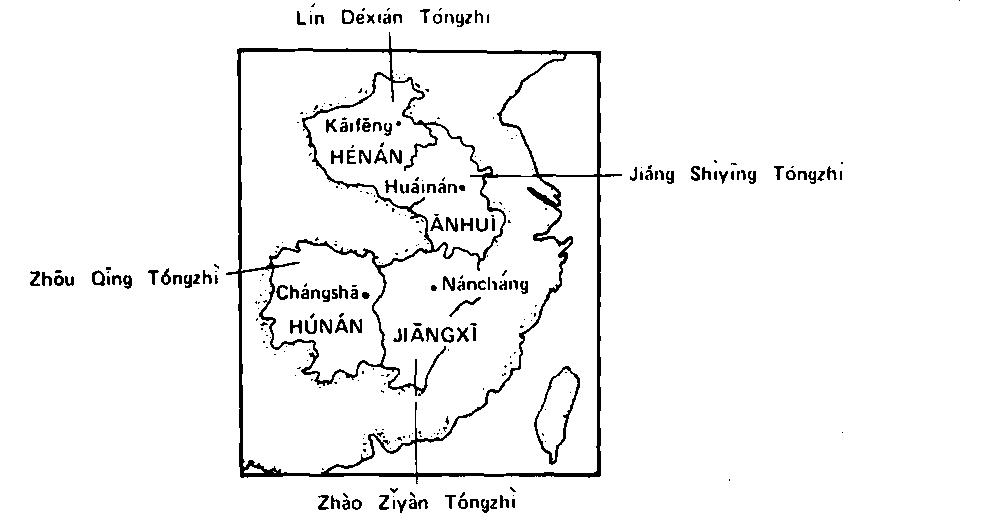
|
1. |
()Yes |
()No |
7- |
()Yes |
()No |
|
2. |
()Yes |
()No |
6. |
()Yes |
()No |
|
3. |
()Yes |
()No |
9. |
()Yes |
()No |
|
k. |
()Yes |
()No |
10. |
()Yes |
()No |
|
5. |
()Yes |
()No |
11. |
()Yes |
()Mo |
|
6. |
()Yes |
()No |
12. |
()Yes |
()No |
Display II is a map indicating the names and tirthplaces of four people now living in Taipei, Exercise 2- is a series of questions about the people. After listening to each question-word question, put a check mark in front of the response that gives the information requested. After each yes/no question, check ”yes” or ”no•” There is a pause on tape before the speaker answers each question.
(Notice that all the ’’yes” and "no’1 answers start out' with shi and tushi.)
|
DISPLAY II |
 |
| ||||||||||||||||||||||||||||||||||||||||||||||||||||||||||||
|
IT |
In this exercise you will work on your comprehension of questions which jstsk who different people are and what their names are. For each item, a speaker vill ask a question about the person whose name is written in this workbook after the item number• All the information you need to answer each question is in the underlined full name and title. Put a check mark in front of the answer that gives the information requested.
Example from the Tape:
SI: Tā shi shéi?
(pause on tape to allov you to mark your ansver)
S2: Tā shi Lin Déxián Tongzhì.
Example from the Workbook:
1. Lin Déxián Tongzhì
(/ Lin Déxián Tongzhì ( ) Lin ( ) Déxián ( ) Yes ( ) No
8. Wáng Dànián Xiānsheng
()Wang Dànìán Xiānsheng ( ) Wáng ( ) Dànián ( ) Yes ( ) No
9. Lin Děxián Tongzhì
()LÍn Déxián Tongzhì ( ) Lin ( ) Dexián ( ) Yes ( ) No
10. Jiang Shìying Tongzhì .
()Jiang Shxying Tongzhì ( ) Jiang ( ) Shìyīng ( ) Yes ( ) No
11. Zhào Zìyàn Tongzhì
()Zhào Zlyàn Tongzhì ( ) Zhào ( ) Zíyàn ( ) Yes ( ) No
12. Zhou Qing Tongzhì
()Zhōu Qing Tongzhì ( ) Zhou ( ) Qing ( ) Yes ( ) No
13. Táng Zhènhàn Xiansheng
()Táng Zhènhàn Xiansheng ( ) Tang ( ) Zhènhàn ( ) Yes ( ) No
Ik. Gāo Dàll Tàitai ()Gáo Dàll Tàitai ( ) Gao ( ) Dàll ( ) Yes ( ) No
15. Fang Mlnzhēn Xiaojie
()Fang Mìnzhēn XiSojie ( ) Fang ( ) Mlnzhēn ( ) Yes ( ) No.
16. Wang Dàniàn Xiansheng
()Wáng Dànián Xiansheng ( ) Wáng ( ) Dànián ( ) Yes ( ) No
For each item in this exercise, a speaker vill introduce himself. Indicate by a check mark vhich of the two romanized names is the one he gave. Then the speaker will tell you vhich one is and vhich one is not the one he gave. For example, if the speaker says
WS shi Wang Dànìán
you should answer in your workbook
0/) Wang Dànián ( ) Huáng Dànián
Then the speaker will say
Wo shi Wang Dànián, *bú shi Huang Dànián.
(Notice that he mentions the names in left-to-right order.)
For another example, the speaker says
Wo shi Huang Danián.
You should ansver in your workbook
()Wang Danian (^/) Huang Dan ian
Then the speaker will confirm:
Wo bú xxng Wáng, xìng Huang.
(Again, you can rely on his mentioning the choice on the left first and the choice on the right second.)
|
1. |
()Lin Déxián |
()Lin Déqián |
|
2. |
()Jiáng Shìylng |
()Jiang Zhìylng |
|
3. |
()Zhào Ziyàn |
()Zhào Zìyàn |
|
k. |
()Zhou Qing |
()Zhū Qing |
|
5. |
()Táng Zhènhàn |
()Tan Zhènhàn |
|
6, |
()Gāo Dali Tàitai |
()Gāo Dali Tàitai |
|
7. |
()Fáng Mlnzhēn |
()Feng Mlnzhēn |
|
8. |
()Wáng Dànián |
()Huang Dànián |
|
9. |
()Ma Zìqiánff |
()Ma Zhìqiáng |
|
10. |
()Sūn Měilián |
()Sūn Měilán |
|
11. |
()Jiāng Huìvén |
()Jiang Huìvén |
|
12. |
()Jiāng Yongpíng |
()Zhāng Yongpíng |
|
13. |
()Li Huìran |
()Lí Huìrán |
|
Ik. |
()Chāng Lìrong |
()Zhang Lìrong |
|
15. |
()Máo Shìmíng |
()Mao Sìmíng |
|
16. |
()Guo Shàovēn |
()Guō Shàowén • |
|
17. |
()Lou Cheng |
()Luo Cheng |
|
18. |
()Zhang Meizhēn |
()Zhuāng Meizhēn |
|
19. |
()Zhào Jièshl |
()Zhào Jièshí |
|
20, |
()SI Dàivéi |
()Shī Dàiwéi |
For each item, the speaker will tell you where he is from, twice. Write the place name in romanization, including the tone marks. If you need more time to complete an ansver, stop the tape.
1. ___
U. ___. __
5. ____
6. ____
7. _______
8. ______
In this exercise you will fill in the boxes "below with information from a recorded dialogue. You will hear the dialogue three times. As you listen to it for the third time, stop the tape whenever you hear information which you need to fill in a box. (The third time, there will be enough time between sentences for you to stop the tape and start it up again without missing anything-)2
|
MALE SPEAKER |
FEMALE SPEAKER |
OTHER PERSON TALKED ABOUT | |
|
SURNAME |
- 1 | ||
|
GIVEN NAME | |||
|
NATIONALITY | |||
|
PLACE OF ORIGIN |
Display I, on the next page, is a map of part of China shoving the "birthplaces of the four people named in the margins. Use the information in the display to ansver the questions in this exercise. The speaker vill ask each question twice. Then he vill pause to allov you to ansver. (You may stop the tape to give yourself more time if you cannot come up with an ansver right away.) After this pause, the speaker vill give you a correct ansver and then pause again to allow you to repeat it. An example precedes the first item on the tape.
Your ansver may be different from the speaker1s ansver but still perfectly correct. If you are not sure whether yours is right or not, make a note and consult your instructor later.
Display II, on the next page, shows the names and birthplaces of four people now living in Taipei. Use the display to answer the questions in this exercise. The speaker will follow the procedure used for asking questions in Exercise 1.
The names of the eight people in Display I and Display II are numbered. When the speaker says "Number One,n that means that the following questions will "be about the person with the number 1 next to his name. After the speaker says "Number Tvoyour answers should be about Mao Zhìmín Tongzhì, And so forth.
question there will be a the speaker, and then a
be repeated. After each then a confirmation from
Questions will not pause for your ansver, pause for repetition.
NOTE: Wuchang is nov part of a conglomerate of three cities. The conglomerate is imam. as Wuhàn.
|
DISPLAY II | |
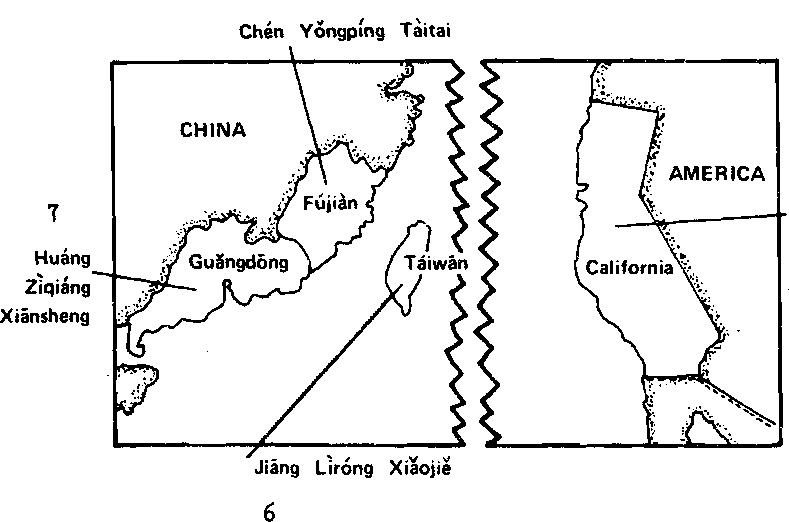 |
5 Wang Danian Xiānsheng ■ |
xThe numbers included in this display are for use in completing Exercise 3.
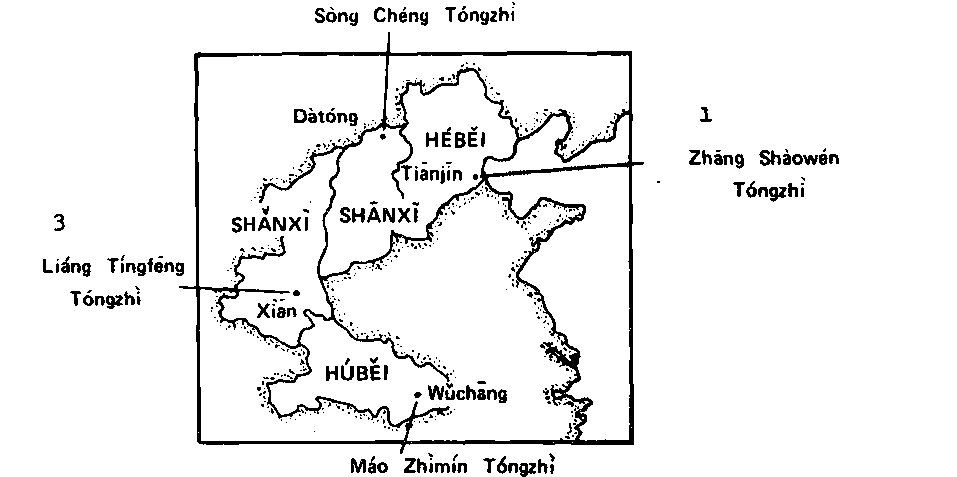
In the conversation on tape, Edvard Smith, from Pennsylvania, is meeting someone for the first time in Taipei. After each question addressed to Smith, try to give the ansver before he does. (You may stop the tape before answering.) Further instructions are on the tape.
Here is the information you vill need for this exercise:
SI Déhuá (Edward Smith)
Bīnzhōu (Pennsylvania)
INSTRUCTIONS:
Type: Matching
|
Situation: The setting is Taipei. You are who meet and talk about what provinces they are from. |
one of four married people and their husbands or wives |
Goal: To find people who come from the same province.
Number of Players: Groups no larger than four players.
Materials: A work sheet for each player. (See Sample Work Sheets, vhich follow.) Your work sheet shows your name, your home province, and the home province of your spouse.
Procedure: For these conversations, use the "mingling” approach; that is, mix freely with the other players in your group to exchange information (no fixed order)*
When you find someone from your province, say in Chinese ’’iPm also from * • • •" Complete your work sheet by filling in the home provinces of the other players and their spouses as you learn them.
Example: You are Speaker 1 (Si).
SI: Nín guìxìng?
S2: WS xìng MS. Nì shi shéi?
SI: Wo shi Li Shoutiān. Mǎ Xiansheng, nì shi nǎràe rén?
S2: Wo shi Shandong rén«
SI: Tàitai shi narde rén?
S2 Tā shi Hetei rén.
SI: Wo jrS ("also”)shi Hé'běi rén.
Additional Note; Notice in the last line of the example that the new vord yě, "also/1 is used before the verb shi. Ye is not introduced until Unit U, "but try to use it nov when you point out a match.
Practice Points: Nǎrde rén, (province) rén, 、
SAMPLE WORK SHEETS:
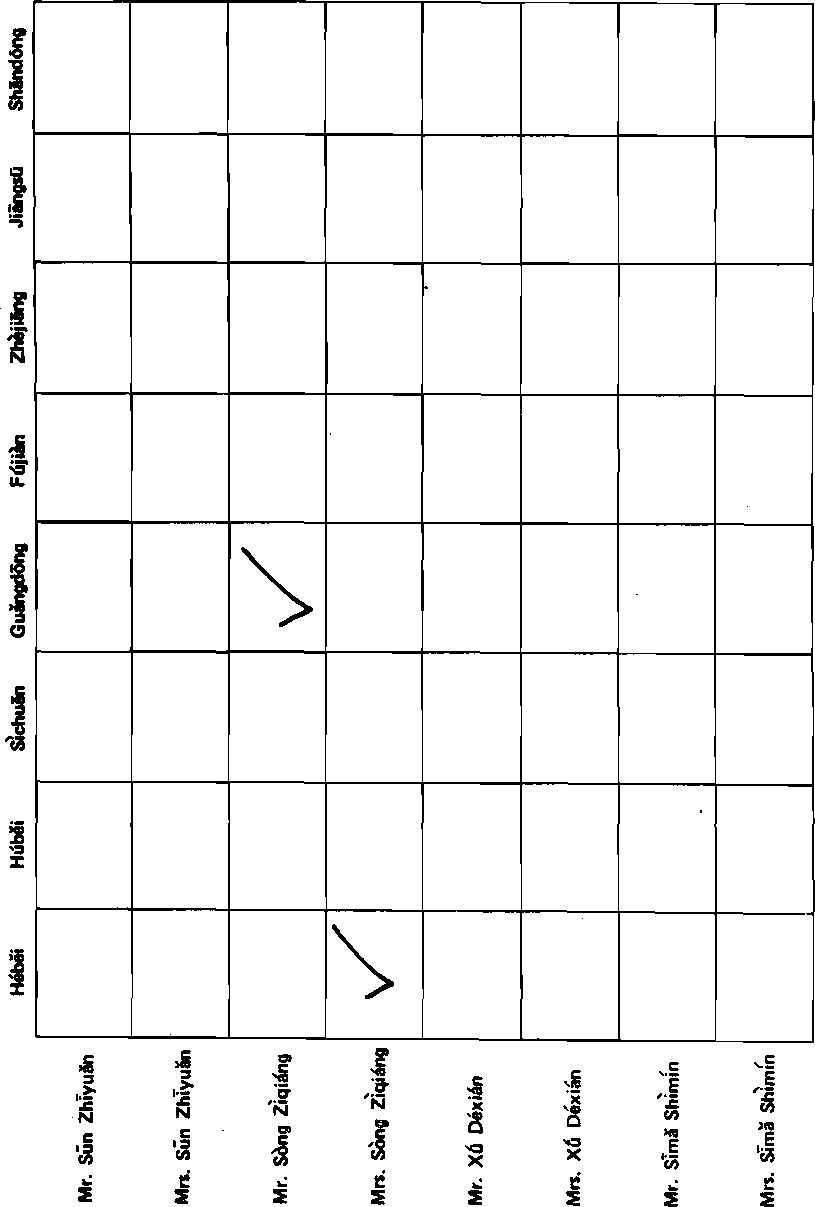
ORN workbook. Unit 3
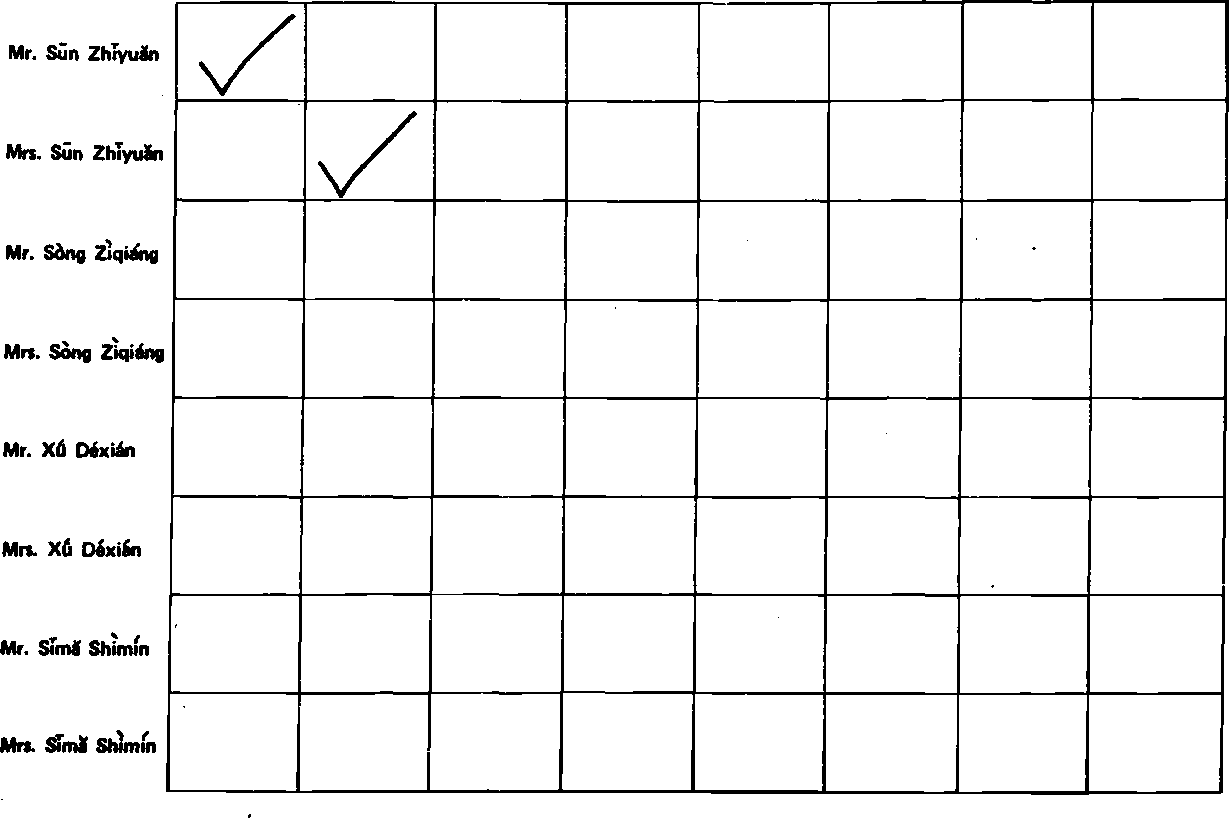
ORN Workbook, Unit 3
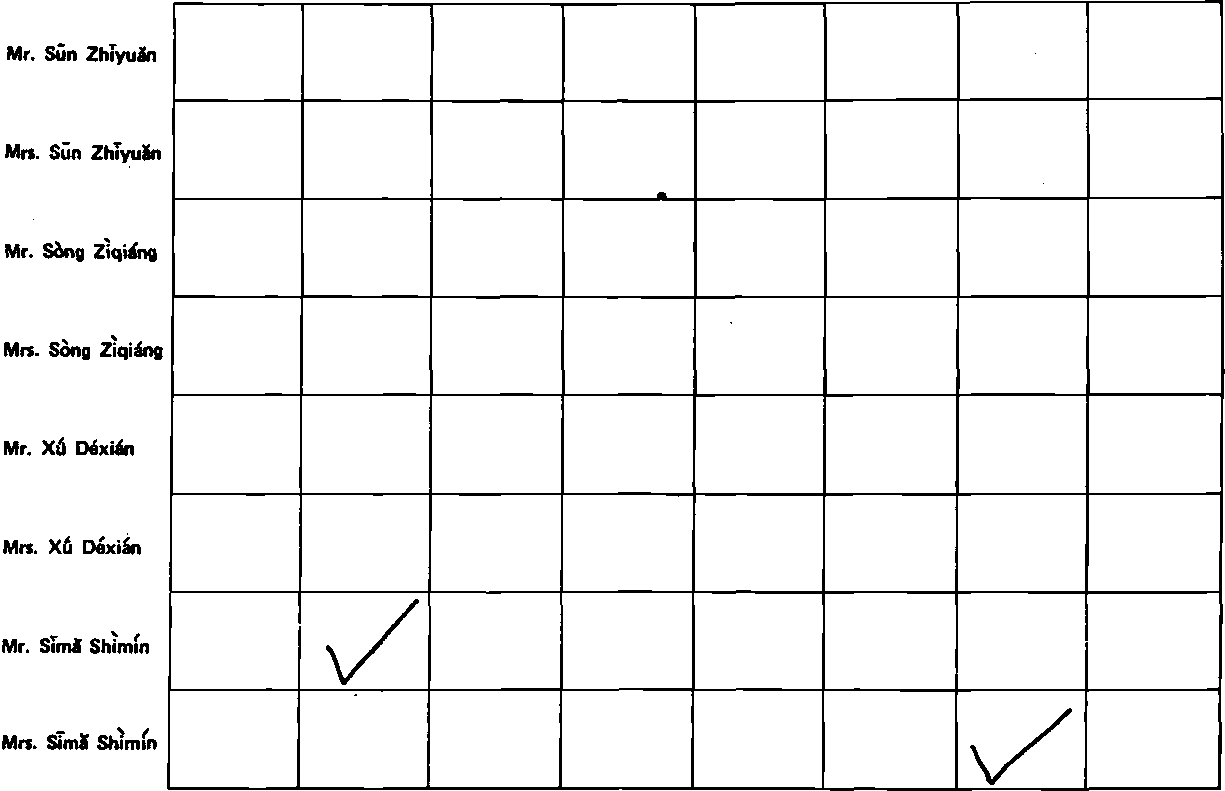
ORN workbook. Unit 3
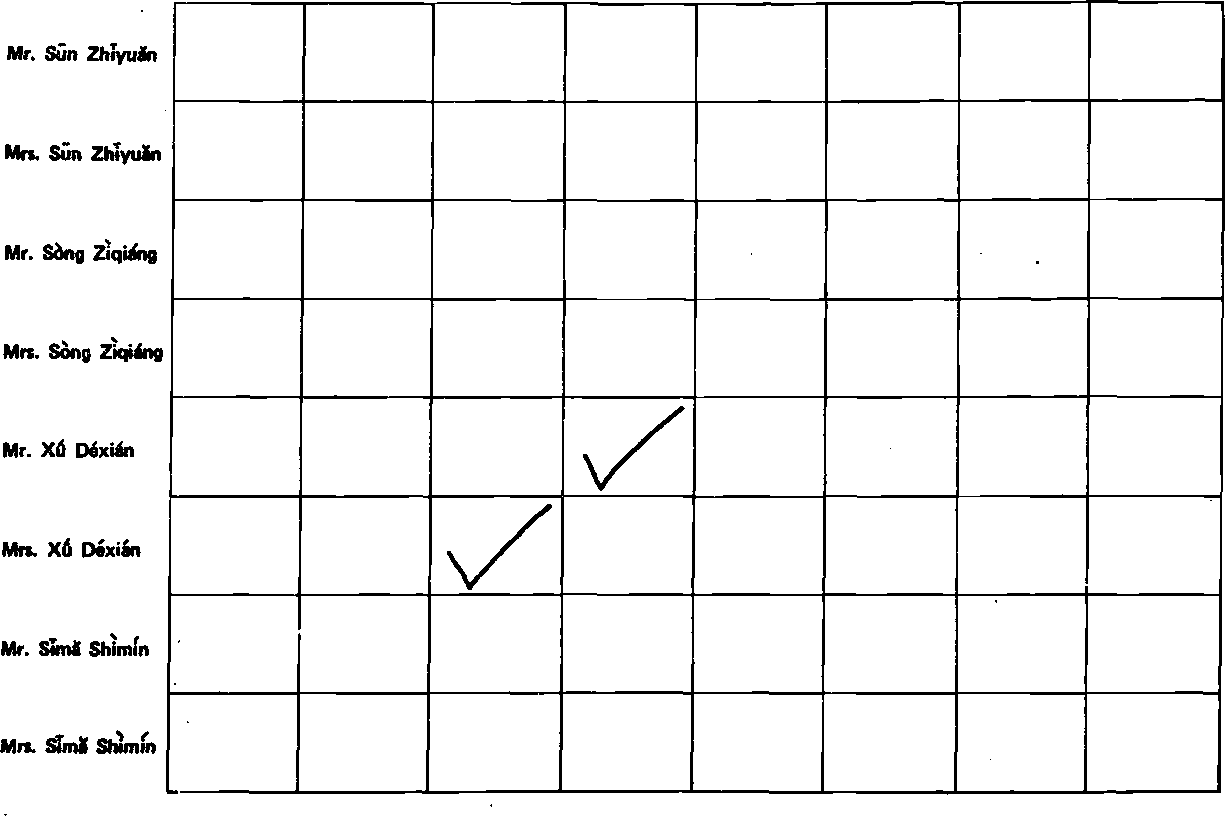
This exercise is based on a conversation betveen Mr. Davis and Comrade Qlán, who have just met. You will hear the conversation three times. As you listen to it for the third time, stop the tape as needed to write dovn information required to complete the chart below.
Here are vocabulary items you vill need for this exercise: Niǔyüēzhōu (New York State)
Blnzhōu (Pennsylvania)
|
HOME STATE OR PROVINCE |
PRESENT LOCATION | |
|
Mr. Davis (Dàivéisī) | ||
|
Comrade Qlán | ||
|
Mrs. Davis | ||
|
Comrade Qiánfs husband |
In this exercise you will listen to fifteen recorded passages in which the names of people1s home provinces are mentioned. After hearing each passage, write in Pinyin romanization the name of the person*s home province in the blank "beside his name.
You will hear each passage twice. After listening for the second time, fill in the "blank. You may stop the tape if you need extra time to write, and you may rewind if you need to listen again.
HOME PROVINCE
1. Wáng Guìfān _—_
2. He Róngvìáng __
3. Sūn Gu6píng ____
U. Féng Guéān __
5. Li Bǎoyí _ ._
6. Zhōu Shàohuá _
7. Wú Yùfān _'■_
8. Chén Shūyí ____
9. Zhōu Dày5u ___
10. Sh§n Xiüylng __
11. Táo Ailing _
12. Yáng Wěìgu6 _
13. Qián Wgidá _____
lU. Zhèng Zhìpíng ___
15- Huáng Huìzhū _
16. Zhū Xiùméi _
17. Bái Mínghuā _
This exercise is based on a conversation between Mr. Bailey and Comrade Fāng vhich takes place vhen they happen to meet on the street.
They have been introduced previously but have never had a chance to talk.
The conversation has deliberately not been edited to the point where you can understand everything, but you should be able to understand enough to complete the chart belov. Imagine yourself in China, listening to a conversation "between two fluent speakers of Chinese. Try to understand as much as you can.
You vill hear the conversation three times. As you listen to it for the third time, stop the tape as needed to vrite down information.
|
HOME STATE OR PROVINCE |
PRESENT LOCATION | |
|
Mr. Bailey (Bèilì) | ||
|
Comrade Fang | ||
|
Mrs. Bailey | ||
|
Comrade Fang1s husband |
In this exercise you will practice talking about where people are in terms of "here” and "there•代
The Display I diagram sets the scene. The two speakers on tape are standing in front of the Beijing Hotel. (They are represented by the solid triangle [the man] and the solid circle [the woman].) Comrade Gāo and Comrade Zhào are standing nearby, near enough to be considered ”here," although neither is in the conversation. Comrade Ma and Comrade Chén are in sight across the street, definitely "there.n (These four people are represented by the outline triangles and circles,)
During the pause on tape after each question asked "by the First Speaker, try to give an ansver. Then you vill hear the Second Speaker,s ansver. Repeat it during the pause which follows.
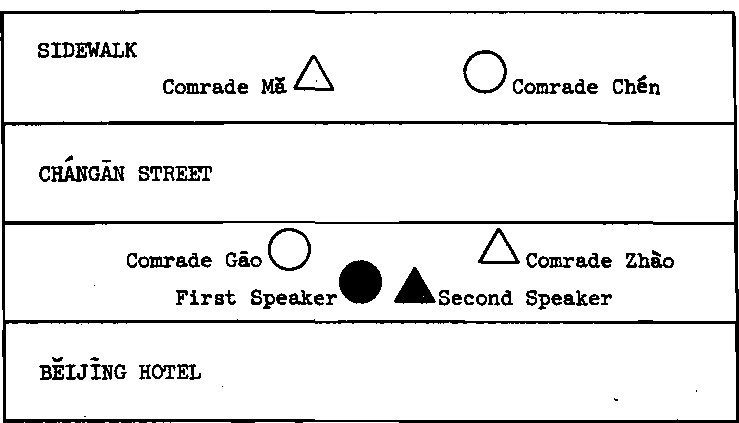
In this exercise you will talk ábout vhere people are from and where they are now.
Display II contains the information needed to ansver the questions on tape. This display shovs the birthplaces and present locations of three people. The solid axrovs show that Comrade Lí vas bom in Sìchuān and that Comrade Lu (his wife) and Comrade Lü were born in YtSnnán. The broken arrows shov that Comrade Lī and his wife are presently in Sichuan and that Comrade Lü is in Yünnán. (This exercise does not make reference to the cities of Chéngdū and Künmíng.)
Ansver each question, and repeat the acceptable answers which follow your responses. If you need time to work out an ansver, stop the tape. Keep in mind that your ansver may have teen perfectly correct even if it vas not worded exactly like the answer on tape. You should l>e able to decide whether your ansver was correct or not. If you are not sure, write down the question and your ansver, and consult your teacher later.
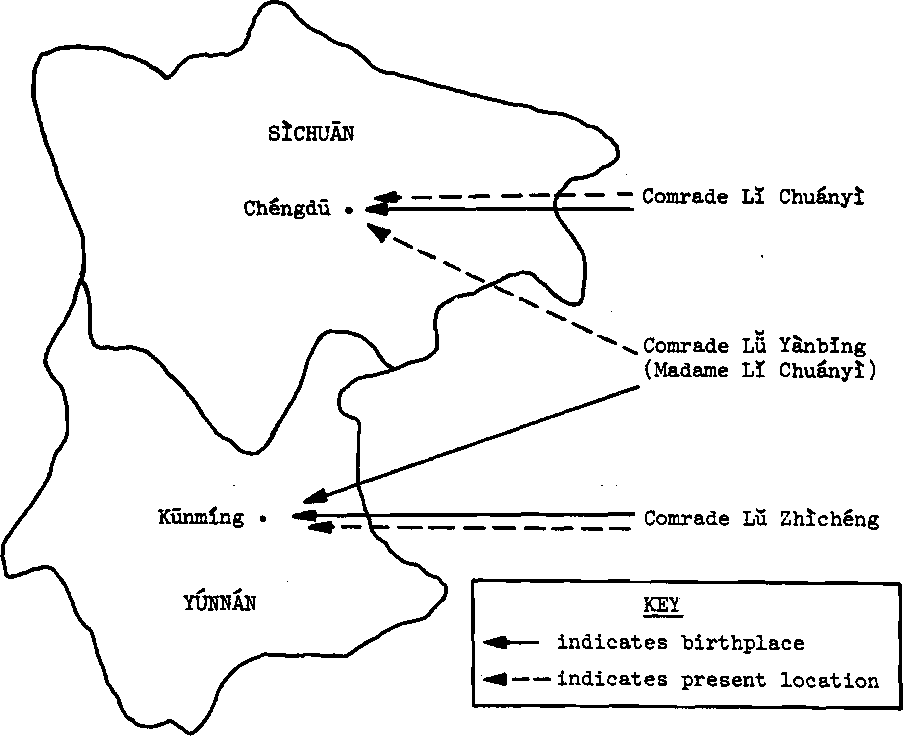
This exercise is a continuation of Exercise 2 and is based on Display II. In this exercise the cities of Chéngdū and Kunming are mentioned.
This exercise gives you a chance to ansver questions you are likely to be asked vhen first meeting someone•
In the recorded dialogue, Comrade Qian is beginning a conversation with Mr. Davis• They are in Běijīng. Use the information in Display III to ansver each question asked "by Comrade Qián, Then listen to Mr. Davisì ansver. Finally, repeat his answer.
|
DISPLAY III | |||||||||||||||
|
INSTRUCTIONS:
Type: Matching
Situation: The setting is Taipei. You are talking with someone about what provinces eight other people are from and what provinces they happen to *be in now.
Goal: To find people from the same home province or people who are now in the same province.
Number of Players: Pairs of students.
Materials: A fact sheet for each player. (See Sample Fact Sheets, which follow.)
Each of the four arrows on a fact sheet is labeled with a person's name and leads from his home province to the province where he is nov.
The names of the four people your partner knows about are listed in the lower left-hand corner of the fact sheet.
Procedure: Each player should ask about the home provinces and current locations of the four people his partner knows about. (No fixed order for asking questions.) While questioning your partner, scan your fact sheet for matches. When you find a match, point it out immediately, using the word 这,"also."
Example: You are Speaker 1.
SI: Táng Yongpíng lSojìā zài nar?
S2: Tǎ lSoJia zài HébSi.
SI: Ta xiánzài zài nSr?
S2: TS xìànzài zk± Shandong.
SI: Li Shìmín xíènzkí y§ zài Shandong*
|
Additional Note: If you donft recognize the you don*t know where a province is, refer to name of a province or if the map in your textbook. |
You may also ask your teacher vhere a province is, but only in Chinese! Practice Points: LaoJiā zài, xiànzài zài,ye.
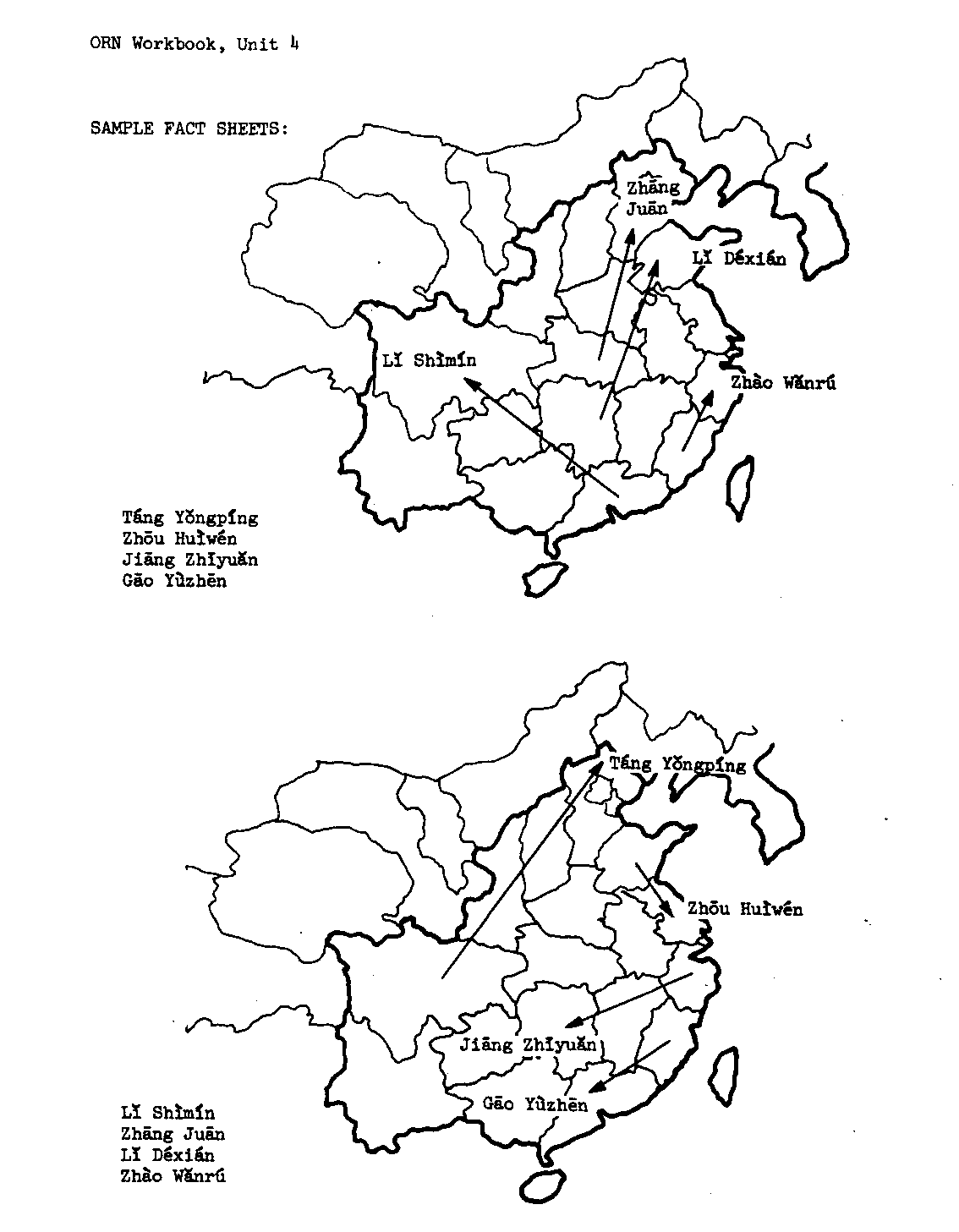
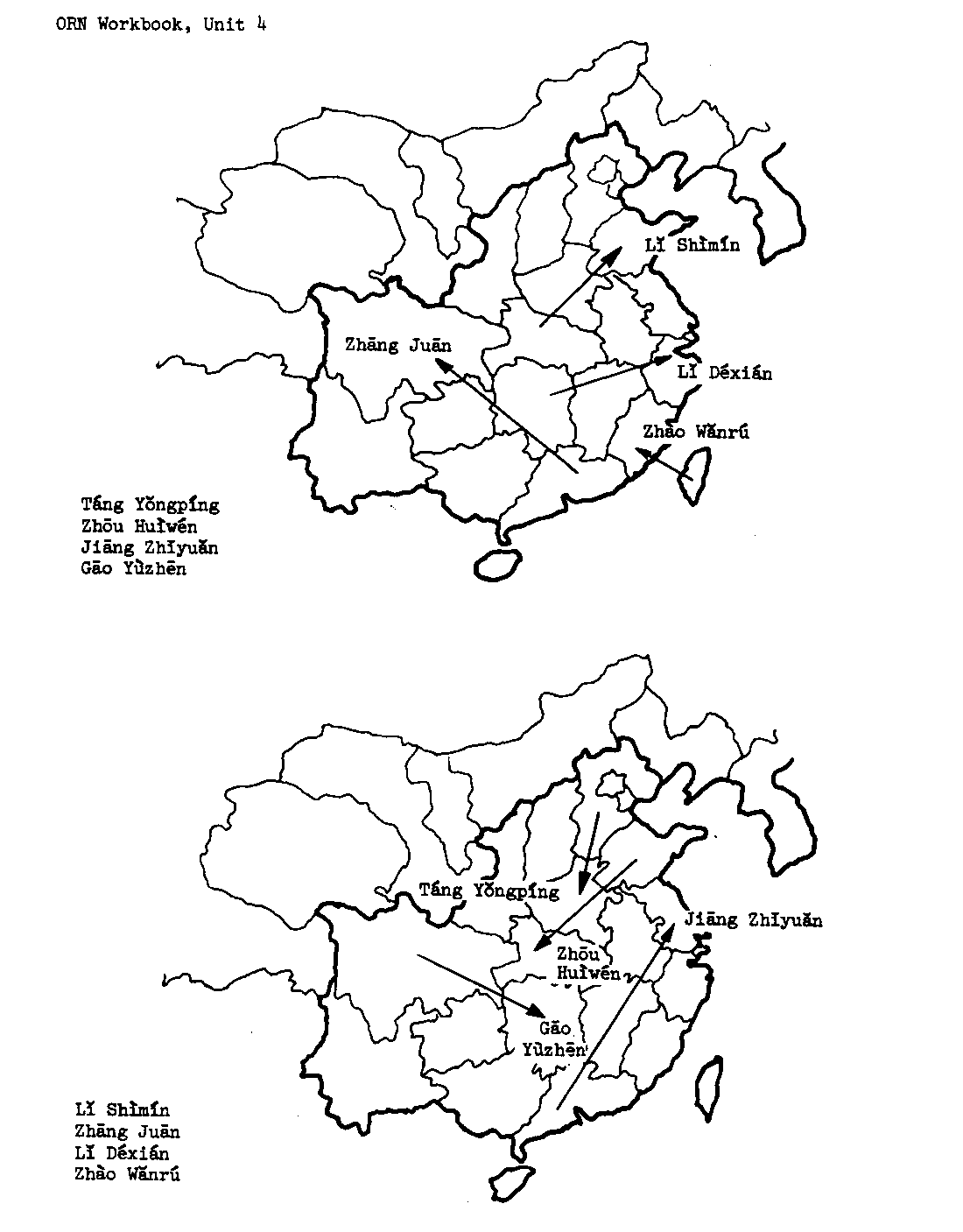
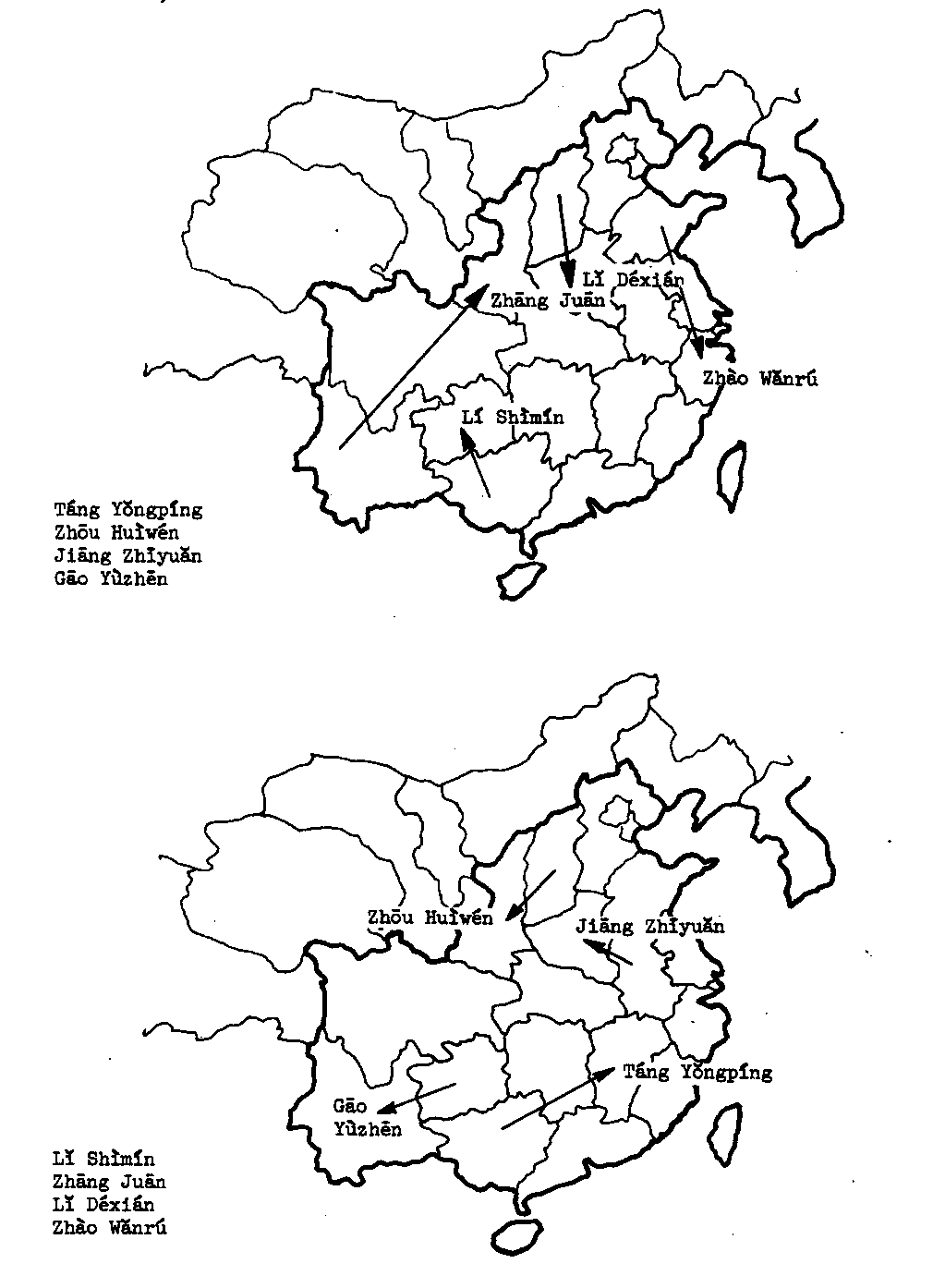
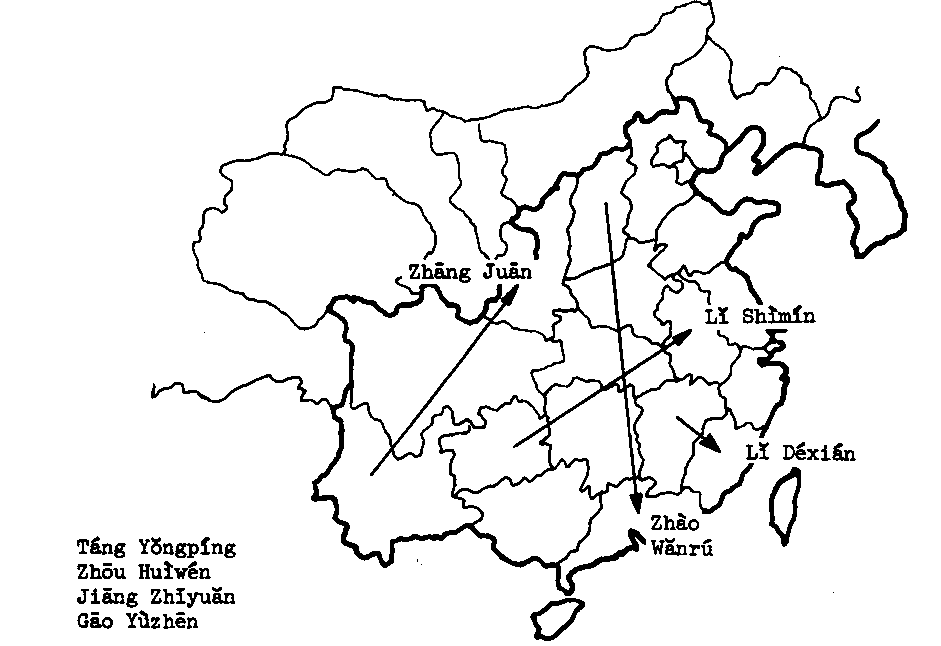
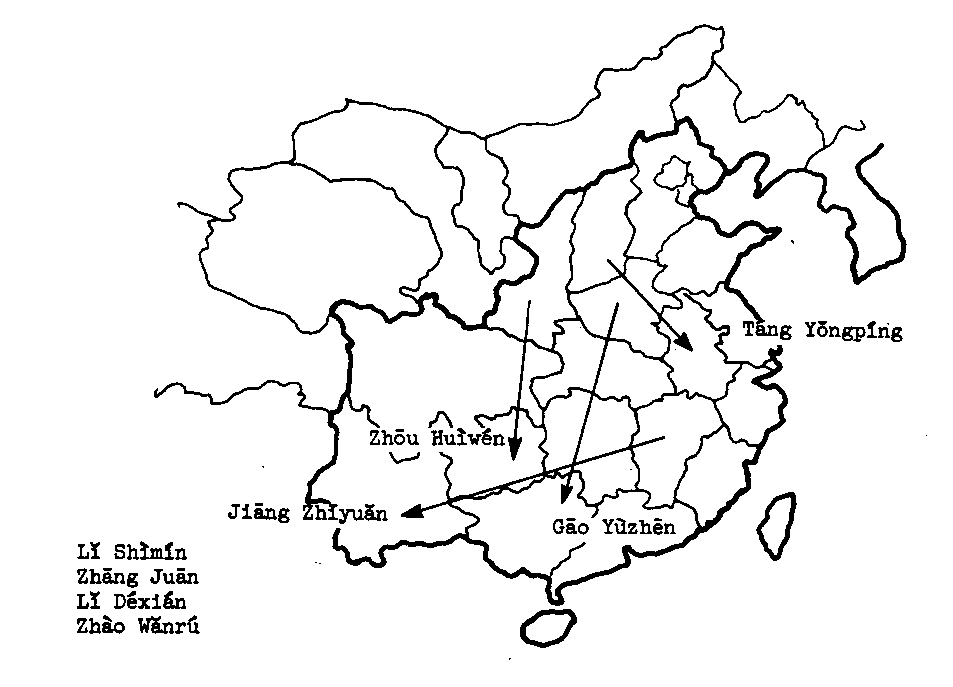
UO
Module & Unit
|
a |
(question marker) |
1.2 |
|
àiren |
spouse |
1.4 |
|
ba |
(marker for a question which expresses the speakerfs supposition as to what the answer will be) |
2.2 |
|
bàba |
papa, dad, father |
2.3 |
|
bìng |
to become ill |
2.8 |
|
BīnzhSu |
Pennsylvania |
1.3°, l.U* |
|
bù/bú |
not |
1.2 |
|
bú shi |
not to be |
1.2 |
|
bú zài le |
to be deceased |
2.5* |
|
congqián |
"before, previously |
2.6 |
|
dà |
to be large |
2.8°, CE 2 |
|
dàfàndiàn |
hotel |
2.2 |
|
dào |
to arrive |
2.U |
|
dàshǐ |
ambassador |
2.2° |
|
dàxué |
university |
2•了 |
|
-de |
(possessive marker) |
2.2 |
|
Déguo (Déguo) |
Germany |
1.3 |
|
Déwén |
German language |
2.7°, 2.8 |
|
Dézhou |
Texas |
l.U |
|
dì- |
used in forming ordinal munbers |
l.U |
|
dìdi |
younger brother |
2.3 |
|
Dìyī Dàfàndiàn |
First Hotel (name of a hotel in |
2.2* ' |
|
Taipei) | ||
|
dìzhī |
address |
2.2 |
|
dong |
to understand |
2.8°i CE 1 |
|
dou |
all, both |
2.3 |
|
dUX |
to be correct |
2.8°, CE 1 |
|
duìbuq.í |
Ifm sorry, excuse me |
1.4° |
|
duì le |
yes, thatfs right |
2.1, CE 1 |
|
duo dà |
how old |
2.5 |
|
iuo jiǔ |
how long |
2.6 |
ĪOTE: The symbol appears after the module and unit reference for
vocabulary items which are not required either for comprehension or production.
|
Éguo (Èguo)(-guo) |
Russia |
1.3 | |
|
èr |
two |
NUM 1 | |
|
Èryüè (Èryüe) |
February |
2.5, |
T&D 1 |
|
érzi |
son |
2.h | |
|
Fǎgu6 (Fàgu6)(-guo) |
France |
1.3 | |
|
fanchéng |
to translate into |
CE 2 | |
|
fàndiàn |
hotel; restaurant |
2.1 | |
|
Fawén (Fàwén) |
French language |
2.7°, |
2.8 |
|
fayīn |
pronunciation |
CE 2 | |
|
fùmǔ |
parents |
2.3 | |
|
fùqin |
father |
2.3 | |
|
fūren |
Mrs., Lady, Madame; a very polite word for the wife of a high-ranking person |
l.U | |
|
-ge |
(general counter) |
2.1, |
2.3 |
|
gege |
older brother |
2.3 | |
|
gen |
and; with |
2.3 | |
|
gongzuò guìxìng |
to work |
2.2 | |
|
your honorable surname |
1.2 | ||
|
-gu6 |
country |
1.3 | |
|
•guo |
(experience marker) |
2.6 | |
|
Gu6bīn Dàfàndiàn |
Anibassador Hotel (name of a hotel in Taipei) |
2.2 | |
|
hái |
still |
2.3 | |
|
haijün |
navy |
2.8 | |
|
háìzi |
child, children |
2.3 | |
|
hao |
to be good, to be well |
2:2 | |
|
-hào |
no. (in addresses, etc.); day of the month |
2.2 | |
|
hen |
very |
2.1 | |
|
hòunián (hòunian) |
the year after next |
2.5, |
T&D 2 |
|
hòutian (hòutian) |
the day after tomorrow |
2.U, |
T&D 2 |
|
huì |
to know how to, can; to have the skill or knowledge of, to know |
2.7, |
2.8 |
|
huídá |
to answer, to reply |
CE 2 | |
|
jl- |
hov many |
2.3 | |
|
JiS |
plus; to add |
NUM |
4 |
|
Jia |
home |
2.2 | |
|
-jia |
(counter for institutions) |
2.3° | |
|
jiāli |
family |
2.3 |
|
jiàn |
to meet |
CE 2 |
|
Jianádà |
Canada |
l.U |
|
jiào |
to be called, to be given-named |
1.2 |
|
Jiazhou |
California |
1.3 |
|
jie |
street |
2.2 |
|
jiéhūn (jiehün) |
to get married, to be married |
■ 2.U# |
|
jiějie |
older sister |
2.3 |
|
jiěmèi |
sisters |
2.3 |
|
jǐge xīngqī |
how many weeks |
2.6 |
|
jxge yüè |
how many months |
2.6 |
|
jíhào |
what day of the month |
2.5, T&D 1 |
|
jīngjìxüé |
economics |
2.7 |
|
jínián |
how many years |
2.6 |
|
jīnnián (jīnnian) |
this year |
2.5, T&D 2 |
|
jíntiān (jintian) |
today |
2.U, T&D 1 |
|
jísuì |
how old |
2.5 |
|
jitian |
how many days |
2.6 |
|
jiǔ |
nine |
NUM 2 |
|
jiù |
only |
2.3 |
|
Jiǔyüè (Jiǔyüe) |
September |
2.5, T8cD 1 |
|
jlySè |
what month . |
2.5 |
|
jüngiiān |
military officer |
2.8 |
|
jSnrén |
military person |
2.8 |
|
kè |
class |
2.8 |
|
k^shi |
but |
2.U* |
|
kongjun |
air force |
2.8 |
|
lái |
to come |
2.U |
|
lSojia |
"original homeff |
l.k |
|
lǎoshl |
teacher |
CE 2 |
|
le |
(combined le: new-situation |
2.k |
|
and completion marker) | ||
|
le |
(new-situation marker) |
2.5 |
|
le |
(completion marker) |
2.6 |
|
liang |
tvo |
2.3 |
|
llbàijí |
vhat day of the week |
T&D 2 |
|
Lí"bàitian |
Sunday |
T&D 1 |
|
Líbàiyī ■ |
Monday |
T&D 2 |
|
ling |
zero |
NUM 1 |
|
lìshǐ |
history |
2.7 |
|
liù |
six |
NUM 1 |
|
Liùyüè (Liùyüe) |
June |
2.5, T&D 1 |
|
lù |
road |
2.2 |
|
luguan |
hotel |
2.1° |
|
lùjun |
army |
2.8 : |
|
ma |
(question marker) |
1.2 | |
|
mama |
momma, mom, mother |
2.3 | |
|
man |
to be slow |
CE 2 | |
|
méi |
not, not to have |
2.3 | |
|
Meiguo (Měiguo) |
America, United States |
1.3 | |
|
Meiguo Guojì |
U.S. International Communica |
2.2* | |
|
Jiāoliú Zongshǔ |
tions Agency | ||
|
Meiguo Guowùyüàn |
U.S. State Department |
2•了 | |
|
Meiguo Yínháng |
Bank of America |
2.2。 | |
|
méi jiéhün |
not to be married |
2.1;° | |
|
raèimei |
younger sister |
2.3 | |
|
méi(you) |
not to have; there isnft/aren!t |
2.3 | |
|
-men |
plural suffix |
2.3 | |
|
Měngtèruì |
Monterey |
2•了。 | |
|
míngnián |
next year |
2.5, |
T&D 2 |
|
(míngnian) | |||
|
míngtiān |
tomorrow |
2.U, |
T&D 2, CE 2 |
|
(míngtian) | |||
|
míngzi |
given name |
1.2 | |
|
mǔqin |
mother |
2.3 | |
|
nà |
that |
2.2 | |
|
nàge |
that (one) |
2.2 | |
|
náli |
where |
2.2 | |
|
náli |
Not at all! |
2. 了 | |
|
nàli |
there |
2.2 | |
|
nan |
to be difficult |
2•了 | |
|
nánháizi |
boy |
2.3 | |
|
nánpéngyou |
boyfriend |
2.3° | |
|
nar |
where |
l.k | |
|
nàr (nèr) |
there |
l.U | |
|
ne |
(question marker) |
1.2 | |
|
něi- |
which |
2.1 | |
|
něige |
which |
2.1 | |
|
nèige |
that |
2.1 | |
|
něigué |
vhich country |
1.3 | |
|
něinián |
which year |
2.5 | |
|
neitian |
which day |
2.U | |
|
nèr (nàr) |
there |
l.U | |
|
ní |
you |
1.1 | |
|
-nián |
year |
2.5, 2.5P |
T&D 2 |
|
niánji |
age, years old | ||
|
niánnián |
every year |
2.5 | |
|
niàn shü |
to study |
2•了 | |
|
niàn |
to study |
2•了 | |
|
nimen |
you (plural) |
2.3 | |
|
nín |
you (polite) |
1.2 |
|
Niu Yüě Niu Yüe Zhou nüér nuháizi nSshì nutóngzhì |
New York New York State daughter girl Ms., Miss; lady (female) C omrade |
2.6 iX 2.h 2.3 I.U., 2.1 2.3. |
|
péngyou pubù |
friend waterfall |
2.2 2.3# |
|
身 qiánnián (qiánnian) qiántiān (qiántian) qlngchu ^ngdao qíngwèn Qīyüè (Qíyue) qunián (qünian) |
seven the year before last the day before yesterday to be clear Qingdao (a city in Shandong province) May 工 ask.•. July to go last year |
NUM 2 2.5 2.U CE 2 l.k l.k 2.5, T&D 1 2.6 2.5, T4D 2 |
|
rén Rìběn Rìwén rongyi |
person Japan Japanese language to be easy |
1.3 1.3 2.7 2.7 |
|
sān Sanyüè (Sanyue) Shandong shàngge shàngge xīngqī shàngge yüè Shanghai shàng kè shàoxìào shěi sheng shengyīn (shengyin) shénme shénme dìfang |
three March Shandong (a province of China) last, previous (i.e., last month, shànffffe vüè) last week last month Shanghai to begin class, to attend class major (military title) vho to be born voice, sound, noise what where, what place |
NUM 1 2.5, T&D 1 1.1* 2.5°, T&D 2 2.5", T&D 2 2.5°, T8tD 2 1.3 CE 1 2.2 1.1 2.5 CE 2 1.1 2.7° |
|
shénme shíhou |
when, what time |
2.h | |
|
shi |
ten |
NUM í |
> |
|
shi |
to be |
1.1 | |
|
shi |
yes, that1s so |
2.1 | |
|
shìbīng |
enlisted man |
2.8 | |
|
shìde |
yes, that1s so |
2.2 | |
|
shi...-de |
(focus construction) |
2.h | |
|
Shíèryüè (Shíèryüe) |
December |
2.5, |
T&D 1 |
|
shìguān |
sergeant |
2.8° | |
|
shíhou |
time |
2.U | |
|
Shíyīyüè |
November |
2.5, |
T&D 1 |
|
(Shíyiyüe) | |||
|
Shíyuè |
October |
2.5, |
T&D 1 |
|
(Shíyüe) | |||
|
shu |
book |
2.7° | |
|
shuo |
to say, to speaJc |
CE 1 | |
|
shuo |
to speak a language |
2.7 | |
|
shu5 |
to say that.•• |
2•了 | |
|
shuōcuò |
to speak/say incorrectly |
CE 2 | |
|
si |
four |
NUM : |
L |
|
Sxyüè (Sìyüe) |
April |
2.5, |
T&D 1 |
|
-suì |
year (of age) |
2.5 | |
|
suìshu(r) |
age |
2.5° | |
|
tā |
he, she, it |
1.1 | |
|
tài |
too, excessive |
CE 2 | |
|
tàitai |
Mrs.s wife |
1.1 | |
|
Taiwan Yínháng |
Bank of Taiwan |
2.2° | |
|
taraen |
they |
2.3 | |
|
-tang |
class period |
2.8° | |
|
-tian |
day |
2A | |
|
tiāntian |
every day |
2.U' | |
|
ting、 |
to listen |
2。8。 |
,CE 1 |
|
tongzhì |
comrade |
1.1 | |
|
Wàijiao Xuéyüàn |
Foreign Service Institute |
2.7° | |
|
wàizufù |
maternal grandfather |
2.3 | |
|
wàizǔmǔ |
maternal grandmother |
2.3 | |
|
-vèi |
(polite counter for people) |
2.1 | |
|
wen |
to ask (for information) |
l.k9 |
,CE 2 |
|
wèntí |
question, problem |
CE 2 | |
|
wenxue |
literature |
2.7 | |
|
wo |
I,me |
1.1 | |
|
women |
we, us |
2-3 | |
|
wǔ |
five |
NUM |
1 |
|
Wǔguānchù |
Defense Attache1s Office |
2.2 | |
|
Wǔyíiè (Wǔyüe) |
May |
2.5, |
T&D 1 |
|
xiàge |
next (i.e., next month, xiage yuej |
2.5., T&D 2 |
|
xiàge xīngqi |
next week |
2.5#, T&D 2 |
|
xiàge yüè |
next month |
2.5# |
|
xià kè |
to end class |
CE 1 |
|
xiang |
to think that; to want to, would like to |
2.5#, 2.6 |
|
xiansheng |
Mr., sir |
1.1 |
|
xiànzài |
now |
l.k |
|
xiaojie (xiaojie) |
Miss |
1.1 |
|
xiě |
to write |
2.8 |
|
xièxie |
thank you |
2.2 |
|
xìng |
to be surnamed |
1.1 |
|
xīngqī |
week |
2.6, T&D 2 |
|
xīngqijǐ |
vhat day of the week |
2.5, T&D 2 |
|
Xīngqītian |
Sunday |
2.5, T&D 2 |
|
XīngqiyT |
Monday |
2.5, T&D 2 |
|
xiongdì |
brothers |
2.3 |
|
xiongdì Jiěmèi |
brothers and sisters |
2.3 |
|
xué |
to study |
2.7 |
|
xüéshèng (xüésheng) |
student |
2•了 |
|
MZ ^ t MZ « \ xuexl (xuexi) |
to study, to learn (PRC) |
2.7 |
|
yě |
also |
l.U |
|
yi |
one |
NUM 1 |
|
yícì |
once, one time |
CE 1, CE 2 |
|
yìdiǎn(dian) |
a little |
2.7» CE 2 |
|
(yìdianr) | ||
|
yíge rén |
singly, alone |
2.U |
|
yíhào (yīhào) |
the first day of the month |
2.5 |
|
yíjīng (yíjing) |
already |
2.U |
|
Yijiǔ nián |
the year 19_ |
2.5 |
|
Yīngguo (Yingguo) |
England |
1.3 |
|
yíng le |
von |
2.3 |
|
Yīngwén |
English language |
2.7 |
|
yínháng |
"bank |
2.2 |
|
yìsi |
meaning |
CE 1 |
|
Yīyüè (Yíyuè) |
January |
.2.5 |
|
(-yue) | ||
|
you、 f |
to have; there is/are |
2.3 |
|
youzhèngjú |
post office |
2.2° |
|
yüè |
month |
2.5, T&D 1 |
|
zài |
again |
CE 1 |
|
zài |
to be in/at/on |
l.b |
|
zài |
in/at/on (prepositional ver"b) |
2.2 |
|
Zao. |
Good morning. |
2.1, CE 1 |
|
zenme |
how |
CE 2 |
|
zhè |
this |
2.2 |
|
zhège |
this (one) |
2.2 |
|
zhèi |
this |
2.1 |
|
zhèige |
this |
2,1 |
|
zhèige yüè |
this month |
2.U。, 2.5。 |
|
zhèli |
here |
2.2 |
|
zhèngzhixüé |
political science |
2.7 |
|
zhèr |
here |
l.U |
|
zhǐ |
only |
2.3 2.8*, CE 1 |
|
zhTdao |
to know | |
|
ZhSngguo (Zhongguo) |
China |
1.3 |
|
Zhongguo huà |
Chinese (spoken) language |
2•了 |
|
ZhSngwén |
Chinese language |
2.7 |
|
zhù |
to stay, to live |
2.1, 2.6 |
|
zì |
character (of Chinese writing) |
2.8 |
|
zǒu |
to leave |
2.U |
|
zufù |
paternal grandfather |
2.3 |
|
zǔmǔ |
paternal grandmother |
2.3 |
|
zuò |
to do, to make |
2. 了 |
|
auò shi |
to work |
2.8 |
|
zuotian (zuotian) |
yesterday |
2.5 |
210
Lin Déxián TSngzhì
()Lin Déxián Tángzhì ( ) Lin ( ) Déxián ( ) Yes ( ) No
A good bit of the dialogue is over your head, but all the information you need is in sentences you should be able to understand.